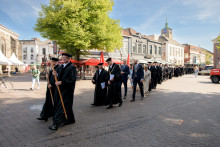They feature prominently at every ceremonial event at UT, yet few people give them a second look. The story really begins with an email from Willem Brinkcate (80), former employee of the central technical service and hobby artist. He was browsing the U-Today archive when he noticed that something was missing: the story of the second mace, which he designed himself in the early 1990s. He promptly put pen to paper and contacted the beadle’s office. ‘For the historical record. I am not immortal, so it seemed wise to have it written down.’
Beadle work
The email exchange happened to coincide with the preparations for the dies natalis, which will take place on Friday 28 November. Traditionally, the celebrations are led by UT’s beadles, Wim Koehorst and Raymond Linderhof. Both walk with a mace, a kind of ceremonial baton used to call gatherings to order by striking it on the floor.

Beadles Wim Koehorst and Raymond Linderhof with their maces.
A framed certificate in the beadles’ small office proves that the first mace was a gift from the rectores magnifici of the technical universities of Delft and Eindhoven during the official opening of the (then) Technische Hogeschool Twente in 1964.
It states in large calligraphic letters that it is a ‘symbolic representation applied in silver on the finial’ and that ‘the senates hereby express their bond with the new technical college and their goodwill towards it’. A striking detail: the certificate is dated 14 September, more than two months earlier than the dies natalis the UT celebrates today.
When the THT grew into a university and the first beadle gained a colleague, a second staff was needed. That is where Brinkcate came in.
Nude woman
He clearly remembers the commission, which came from former rector Jos de Smit. The rector knew Brinkcate had an artistic streak, and asked whether he could ‘come up with something’. The Oldenzaal-based artist could indeed. On a sheet of paper that he still keeps in a folder with all his designs, he sketched two proposals. The first was an elegant nude female figure. ‘Everything begins with women. Nothing exists without them, hence the idea,’ he explains succinctly. But he did not mention that to De Smit. In fact, he never explains his art. ‘A piece of art should speak for itself. If it doesn’t do anything to you, then that’s too bad for you.’
Wim Brinkcate in his 'shed' with the first sketches of the second beadle mace.
Stylised flower
The second design was a stylised flower with four petals, representing the four cardinal directions. A reference to the international character of UT and the students who come to Enschede from all around the world. The two semicircles that seem to pass each other represent the stamens. They symbolise scientific progress, which never stands still and always builds on the work of predecessors.
The inspiration goes back to Brinkcate's early childhood, he says in his living room filled with woodcarvings and artworks. When he was six, his family moved to South Africa, where he climbed a eucalyptus tree in the open landscapes of Transvaal, now Gauteng. ‘The wind swung the tree back and forth. There was no way to tell where it came from at any moment,’ he recalls with wonder. De Smit understood that explanation better. In 1992, the new mace was completed, cast by the Terpstra foundry in Aadorp.
Is he proud of it? In his studio full of paintings, which he calls his ‘shed’, he shrugs. ‘Well, in the end it is all just tinkering. But it is nice that the thing leads the way during such ceremonies.’
Third mace
There is even a third mace in the beadle’s office. A solid black one with little bells on it. Linderhof explains that it was a gift from the ITC faculty.

Professor OlaJide Kufoniyi handing the beadle mace to rector Martien Molenaar in 2003. Picture: ITC archive.
Jorien Terlouw, alumni coordinator at ITC and the faculty’s walking archive, confirms this. By email she explains that the staff was made in 2003 from African ebony in Nigeria, commissioned by alumnus OlaJide Kufoniyi, now professor of geoinformatics at Obafemi Awolowo University. He was inspired by the old ITC logo, which also stands as a sculpture that thousands of students pass daily in front of Langezijds. When ITC became the sixth faculty of UT in December 2009, ITC rector Besemer officially presented the staff to Executive Board president Anne Flierman.
It is not used very often, though. ‘The jingling is rather distracting. We prefer to keep things subtle.’
In short, the mace staffs are symbols of authority and of UT’s connection to the other technical universities. They represent goodwill towards one another and the continuous progress of science. They also serve as a gentle reminder to speakers not to waffle on for too long. Because they are quite hard, indeed.






